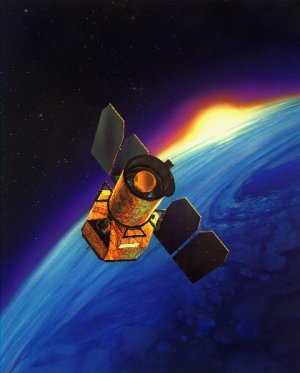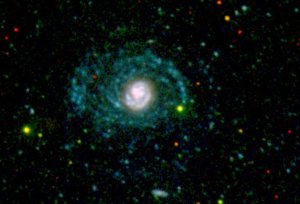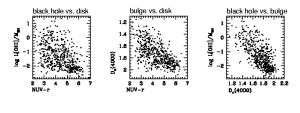|
|  |
Guinevere Kauffmann, astronomer from the Max Planck Institute for
Astrophysics,
in collaboration with colleagues
from the USA, France and Korea, has been analyzing GALEX data in order to
learn about the recent star formation histories
of galaxies in the local Universe.
The analysis has been carried out with galaxies that were observed
both by GALEX and by the
 Sloan Digital Sky Survey,
a very large optical
survey of almost a million nearby galaxies.
The galaxy spectra obtained by the SDSS yield distances, luminosities
and other physical characteristics of the galaxy (see Sloan Digital Sky Survey,
a very large optical
survey of almost a million nearby galaxies.
The galaxy spectra obtained by the SDSS yield distances, luminosities
and other physical characteristics of the galaxy (see
 Research Highlight April 2002),
while the GALEX data are useful for locating young, hot stars.
Research Highlight April 2002),
while the GALEX data are useful for locating young, hot stars.
Traditionally, galaxies in the nearby Universe have been divided into
two major classes: 1) elliptical galaxies, which have massive spheroids
and red optical colours, and 2) spiral galaxies, which have
actively star-forming blue disks. One surprise discovery from GALEX
is that many early-type galaxies that look "red and dead" when
viewed in optical light, turn out to have very extended outer
disks that are only visible in the ultra-violet.
An example of such a galaxy is shown in Figure 2. The galaxy NGC 4265
only showed an oval-shaped ball of light when observed in visible
light. In UV light one sees a disk with a beautiful set of spiral arms
(see
 http://www.galex.caltech.edu/
for a press release about this galaxy). http://www.galex.caltech.edu/
for a press release about this galaxy).
The work of Kauffmann and collaborators extends this result to
the entire population of elliptical galaxies in the
local Universe. The analysis demonstrates that UV disks are a common
phenomenon among this population.
Interestingly, all elliptical galaxies where the
central supermassive black hole is growing at an appreciable rate (see
 Research Highlight July 2004)
have outer UV-bright disks (Figure 3). This suggests that the disks contain
a reservoir of gas necessary for ongoing growth of the central
spheroids and supermassive black holes. The disks are subject to dynamical
instabilities such as warps and bars, and gas will then flow inwards towards
the nucleus of the galaxy.
Research Highlight July 2004)
have outer UV-bright disks (Figure 3). This suggests that the disks contain
a reservoir of gas necessary for ongoing growth of the central
spheroids and supermassive black holes. The disks are subject to dynamical
instabilities such as warps and bars, and gas will then flow inwards towards
the nucleus of the galaxy.
So how do the outer UV disks discovered by GALEX form?
In the standard theoretical scenario, disks form by the
condensation of gas in gravitationally dominant dark matter halos.
If the gas initially has the same angular momentum as the dark matter
and conserves this angular momentum during its contraction, the
distribution of disk sizes can be predicted. These predictions
are found to be in good agreement with the observed sizes of spiral
galaxies. Future work will determine whether the same is true of
the UV disks around ellipticals.
Guinevere Kauffmann
Acknowledgements:
GALEX (Galaxy Evolution Explorer) is a NASA Small Explorer,
launched in April 2003.
We gratefully acknowledge NASA's support for construction, operation,
and science analysis for the GALEX mission,
developed in cooperation with the Centre
National d'Etudes Spatiales (CNES) of France and the
Korean Ministry of Science and Technology.
Publication
Guinevere Kauffmann, Timothy M. Heckman, Tamas Budavari,
Stephane Charlot, Charles G. Hoopes, D. Christopher Martin,
Mark Seibert, Tom A. Barlow, Luciana Bianchi, Tim Conrow,
Jose Donas, Karl Forster, Peter G. Friedman, Young-Wook Lee,
Barry F. Madore, Bruno Milliard, Patrick F. Morrissey,
Susan G. Neff, R. Michael Rich, David Schiminovich,
Todd Small, Alex S. Szalay, Ted K. Wyder, S.K. Yi:
"Ongoing Formation of Bulges and Black Holes in the Local Universe: New
Insights from GALEX",
 astro-ph/0609436 astro-ph/0609436
|


